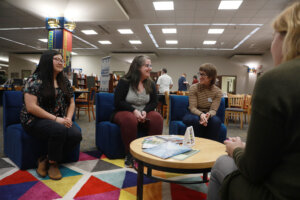
Students who walk past the check-out desk and the “popular reading” display in the University of Mary Washington’s Simpson Library will find a newly named nook.
It’s quiet in the Research and Creativity Collaborative (RCC), but its mission – to highlight UMW’s emphasis on scholarly endeavors and artistic success – comes through loud and clear. A touch-screen kiosk allows access to a repository of original research and student artwork adorns the walls, while hanging plants, table lamps and comfy seating paint a collaborative mood.
“The space is beautiful,” said Director of Undergraduate Research and Professor of Spanish Elizabeth Lewis, who runs the Collaborative, working to match students and faculty with the funding, connections and opportunities it takes to bring their projects to life. “To me it’s a visible reminder of the UMW community’s enthusiasm for these transformative experiences.”
Senior Madison Hinton spoke of her own life-changing endeavor at an open house to début the space early this month. With her sketches and paintings on view, the art major recounted the six summer weeks she spent capturing the lavender fields and mountainous terrain of Aix-en-Provence in the South of France. An essay and portfolio won her a spot in the plein air painting program at the American College of the Mediterranean’s Institute of American Universities, where she also studied masters like Cézanne and Monet.
“I’m excited to see where this space goes,” said Hinton, whose trip was fully funded, thanks to the Rosalie Chauncey Memorial Scholarship in Studio Art.


Joey Gasink and Summer Orledge presented their award-winning posters from UMW’s Irene Piscopo Rogers ’59 Summer Science Institute, named for the late alumna whose $36 million estate gift – the largest gift in Mary Washington history – is meant to further STEM research. Gasink won first place for his exploration of climate change using snails; Orledge took second for her study of trace metal contamination in a Virginia landfill. Assistant Professor Tyler Frankel guided the earth and environmental sciences majors, both seniors, throughout their research.
“Faculty and students come up with the great ideas and do all the hard work,” said Lewis, who’s planning events like a recent new-faculty workshop to increase awareness of the Collaborative. “The RCC is just here to support them.”
Its launch comes at a pivotal time, she said, with the University set to host a Network for Undergraduate Research in Virginia conference this fall, celebrate the 20th anniversary of Research and Creativity Day next spring and welcome its first Piscopo Rodgers Science Fellows cohort in fall 2026.

Lewis planned the space to support students’ mentored investigations, creative inquiries and contributions to knowledge with input from faculty and staff, along with the students themselves. The RCC showcases UMW’s Eagle Scholar repository of research and creativity, holds copies of the humanities and social science journal Columns and features a large-format poster printer, plus materials for meetings and workshops, including a projector and white board.
Financial support came from the College of Arts and Sciences, College of Business, College of Education, Office of the Provost and Simpson Library, along with a Fund for Mary Washington Impact Grant from the Office of Advancement and Alumni Engagement.
“The Collaborative is just the first step,” Lewis said. “I want to be here to help people get access to what they need to have success with their student projects and take them to the next level.”
Visit the Research and Creativity Collaborative website for more information and details on applying for funding.



I like it!